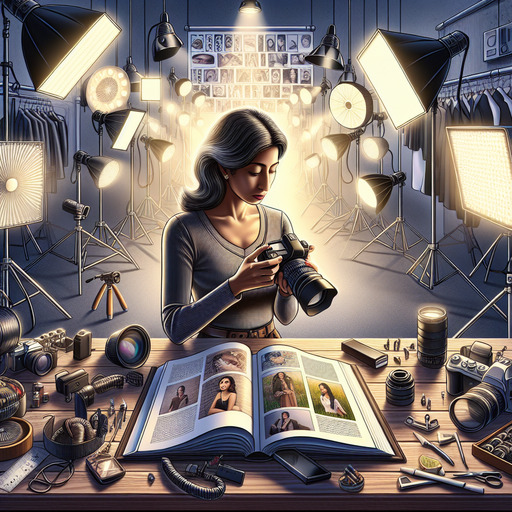
-
Table of Contents
Discover essential photography lighting techniques for different situations and elevate your skills today! Learn More
Introduction
Photography lighting techniques are essential for capturing high-quality images in various situations. Understanding how to manipulate light can dramatically enhance the mood, depth, and overall impact of a photograph. Whether shooting in natural light, using studio setups, or working with artificial sources, each scenario demands a unique approach to lighting. Techniques such as three-point lighting, backlighting, and the use of reflectors and diffusers can help photographers control shadows, highlights, and contrast. Mastering these techniques allows photographers to adapt to different environments, from outdoor landscapes to indoor portraits, ensuring that each shot is perfectly illuminated to convey the desired artistic vision.
Mastering Photography Lighting Techniques for Different Situations: Essential Tips for Professional Portrait and Landscape Photography
Mastering the art of photography lighting is crucial for capturing stunning images, whether you’re focusing on portrait or landscape photography. Understanding how to manipulate light can transform an ordinary photograph into an extraordinary one. In portrait photography, lighting plays a pivotal role in highlighting the subject’s features, creating mood, and adding depth. Conversely, in landscape photography, the quality and direction of light can dramatically alter the scene’s ambiance and detail. Therefore, mastering various lighting techniques is essential for any professional photographer aiming to elevate their work.
In portrait photography, one of the most fundamental lighting techniques is the use of natural light. Natural light, especially during the golden hours—shortly after sunrise and before sunset—provides a soft, warm glow that is flattering for most subjects. Positioning the subject with the light source slightly to the side can create a pleasing effect, adding dimension to the face through soft shadows. However, when natural light is not available or sufficient, artificial lighting becomes indispensable. Studio lighting setups, such as three-point lighting, are commonly used to achieve professional results. This setup includes a key light, which is the primary source of illumination, a fill light to reduce shadows, and a backlight to separate the subject from the background, adding depth to the image.
Transitioning to landscape photography, the approach to lighting differs significantly. Here, the focus is on capturing the natural beauty of the environment, and the time of day becomes a critical factor. The golden hours are equally important in landscape photography, as they provide a soft, diffused light that enhances colors and textures. Midday light, on the other hand, can be harsh and create unflattering shadows. However, this can be mitigated by using techniques such as high dynamic range (HDR) photography, which combines multiple exposures to balance the light and shadow areas in the scene.
Moreover, understanding the direction of light is vital in landscape photography. Front lighting, where the light source is behind the photographer, can make the scene appear flat. Side lighting, however, can add depth and texture by casting shadows that highlight the contours of the landscape. Backlighting, where the light source is in front of the photographer, can create dramatic silhouettes and emphasize the translucency of elements like leaves and water.
In both portrait and landscape photography, the use of reflectors and diffusers can significantly enhance the quality of light. Reflectors can bounce light back onto the subject, filling in shadows and adding a natural glow. Diffusers, on the other hand, soften harsh light, creating a more even and flattering illumination. These tools are particularly useful in outdoor settings where controlling the light can be challenging.
Additionally, experimenting with different light sources and angles can lead to creative and unique results. For instance, using a low-angle light in portrait photography can create a dramatic and mysterious effect, while in landscape photography, capturing the interplay of light and shadow during twilight can result in breathtaking images.
In conclusion, mastering photography lighting techniques requires a deep understanding of how light interacts with the subject and the environment. By utilizing natural and artificial light sources, understanding the importance of the time of day, and employing tools like reflectors and diffusers, photographers can significantly enhance the quality of their images. Whether capturing the intricate details of a portrait or the vast beauty of a landscape, effective lighting techniques are essential for creating professional and captivating photographs.
Q&A
**Question:** What are some effective lighting techniques for portrait photography in an outdoor setting?
**Answer:** Effective lighting techniques for outdoor portrait photography include:
1. **Golden Hour Lighting:** Shoot during the golden hour (shortly after sunrise or before sunset) for soft, warm, and flattering light.
2. **Use Reflectors:** Utilize reflectors to bounce natural light onto the subject, reducing harsh shadows and adding a pleasing fill light.
3. **Backlighting:** Position the subject with the sun behind them to create a halo effect and reduce squinting, using a reflector or fill flash to illuminate the face.
4. **Open Shade:** Place the subject in open shade (like under a tree or next to a building) to avoid direct sunlight and achieve even lighting.
5. **Diffusers:** Use diffusers to soften harsh sunlight and create a more balanced exposure on the subject’s face.